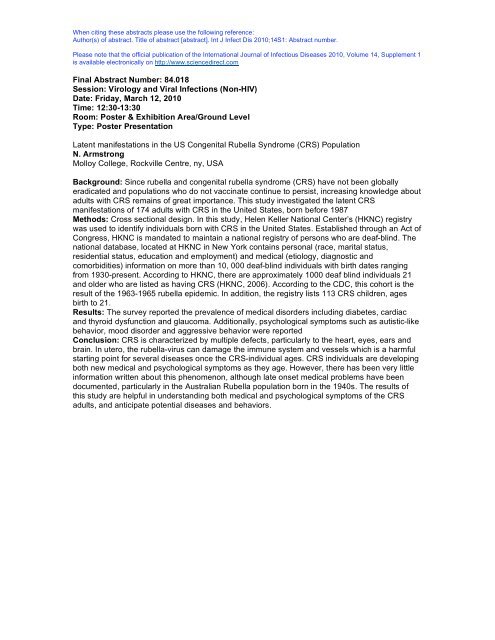14th ICID - Poster Abstracts - International Society for Infectious ...
14th ICID - Poster Abstracts - International Society for Infectious ...
14th ICID - Poster Abstracts - International Society for Infectious ...
You also want an ePaper? Increase the reach of your titles
YUMPU automatically turns print PDFs into web optimized ePapers that Google loves.
When citing these abstracts please use the following reference:<br />
Author(s) of abstract. Title of abstract [abstract]. Int J Infect Dis 2010;14S1: Abstract number.<br />
Please note that the official publication of the <strong>International</strong> Journal of <strong>Infectious</strong> Diseases 2010, Volume 14, Supplement 1<br />
is available electronically on http://www.sciencedirect.com<br />
Final Abstract Number: 84.018<br />
Session: Virology and Viral Infections (Non-HIV)<br />
Date: Friday, March 12, 2010<br />
Time: 12:30-13:30<br />
Room: <strong>Poster</strong> & Exhibition Area/Ground Level<br />
Type: <strong>Poster</strong> Presentation<br />
Latent manifestations in the US Congenital Rubella Syndrome (CRS) Population<br />
N. Armstrong<br />
Molloy College, Rockville Centre, ny, USA<br />
Background: Since rubella and congenital rubella syndrome (CRS) have not been globally<br />
eradicated and populations who do not vaccinate continue to persist, increasing knowledge about<br />
adults with CRS remains of great importance. This study investigated the latent CRS<br />
manifestations of 174 adults with CRS in the United States, born be<strong>for</strong>e 1987<br />
Methods: Cross sectional design. In this study, Helen Keller National Center’s (HKNC) registry<br />
was used to identify individuals born with CRS in the United States. Established through an Act of<br />
Congress, HKNC is mandated to maintain a national registry of persons who are deaf-blind. The<br />
national database, located at HKNC in New York contains personal (race, marital status,<br />
residential status, education and employment) and medical (etiology, diagnostic and<br />
comorbidities) in<strong>for</strong>mation on more than 10, 000 deaf-blind individuals with birth dates ranging<br />
from 1930-present. According to HKNC, there are approximately 1000 deaf blind individuals 21<br />
and older who are listed as having CRS (HKNC, 2006). According to the CDC, this cohort is the<br />
result of the 1963-1965 rubella epidemic. In addition, the registry lists 113 CRS children, ages<br />
birth to 21.<br />
Results: The survey reported the prevalence of medical disorders including diabetes, cardiac<br />
and thyroid dysfunction and glaucoma. Additionally, psychological symptoms such as autistic-like<br />
behavior, mood disorder and aggressive behavior were reported<br />
Conclusion: CRS is characterized by multiple defects, particularly to the heart, eyes, ears and<br />
brain. In utero, the rubella-virus can damage the immune system and vessels which is a harmful<br />
starting point <strong>for</strong> several diseases once the CRS-individual ages. CRS individuals are developing<br />
both new medical and psychological symptoms as they age. However, there has been very little<br />
in<strong>for</strong>mation written about this phenomenon, although late onset medical problems have been<br />
documented, particularly in the Australian Rubella population born in the 1940s. The results of<br />
this study are helpful in understanding both medical and psychological symptoms of the CRS<br />
adults, and anticipate potential diseases and behaviors.
















